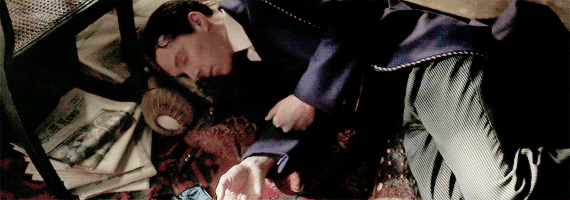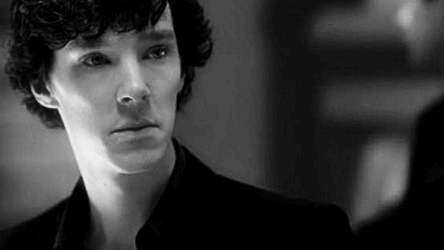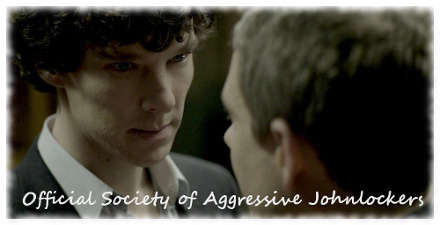Posted by Sherlock Holmes  January 4, 2016 4:19 pm | #1 |
I have some questions as to the quirks and idiosyncracies of Sherlock's mind palace, and why his brain made certain decisions during his drug trip solving of the case...
Why does Sherlock choose to have Watson narrate things inside his head for the first part of the tale?
How does Sherlock know the exact actual conversation that took place between John & Stamford when they first met in the park well enough to replicate it exactly in his Victorian Mind Palace version?
"You're the second person to say that to me today..." etc
And again, how does he know what Stamford said to John that day in Barts hospital after he'd just introduced himself and then walked out? "Yeah, he's always like that."
Why does he choose The Strand Magazine as the location of Watson's stories?
Why did his brain pick the Reichenbach Falls as the location of his imaginary Victorian battle with Moriarty?
Why does Watson argue so much about Holmes' relationships inside Sherlock's head?
Why does Sherlock imagine that Moriarty has been inside his bed?
Was the crazy suffragete style movement an actual feature of the real case, or just something Sherlock made up as part of his own solution?
On the ledge of the Falls near the end, why does Sherlock's brain choose to bring a more self aware Watson into the equation? ie. One that knows he's not real.
---------------------------------------------------------------------------------------------------------------------------------------------
Eventually everyone will support Johnlock.
Independent OSAJ Affiliate

Posted by kgreen20  January 4, 2016 4:54 pm | #2 |
How does Sherlock know the exact actual conversation that took place between John & Stamford when they first met in the park well enough to replicate it exactly in his Victorian Mind Palace version?
"You're the second person to say that to me today..." etc
And again, how does he know what Stamford said to John that day in Barts hospital after he'd just introduced himself and then walked out? "Yeah, he's always like that."
I'm supposing that John or Mike told him. Perhaps both.
Since I haven't seen the special as yet, I'll have to let the others answer your other questions.
Last edited by kgreen20 (January 4, 2016 4:56 pm)
Posted by nakahara  January 4, 2016 5:39 pm | #3 |
kgreen20 wrote:
How does Sherlock know the exact actual conversation that took place between John & Stamford when they first met in the park well enough to replicate it exactly in his Victorian Mind Palace version?
"You're the second person to say that to me today..." etc
And again, how does he know what Stamford said to John that day in Barts hospital after he'd just introduced himself and then walked out? "Yeah, he's always like that."I'm supposing that John or Mike told him. Perhaps both.
Since I haven't seen the special as yet, I'll have to let the others answer your other questions.
Those things were probably mentioned in John´s blog.
The show´s version of the blog is distinctly different from the one we have at our disposition in RL and it´s probably much more detailed.
-----------------------------------
I cannot live without brainwork. What else is there to live for? Stand at the window there. Was there ever such a dreary, dismal, unprofitable world? See how the yellow fog swirls down the street and drifts across the dun-coloured houses. What could be more hopelessly prosaic and material? What is the use of having powers, Doctor, when one has no field upon which to exert them?

Posted by This Is The Phantom Lady  January 4, 2016 6:09 pm | #4 |
^That was just what I was going to say... Sherlock was going through John's blog before he 'dozed off'.
The rest of the list... gosh I'd like to know! Those have been driving me nuts these last days! I want to make sense of it... but some of it just doesn't make sense for me
~~~~~~~~~~~~~~
"Don't talk out loud, you lower the IQ of the whole street!"

"Oh Watson. Nothing made me... I made me"
"Luuuuurve Ginger Nuts"
Tumblr[/url] I [url=http://archiveofourown.org/users/This_is_The_Phantom_Lady/pseuds/This_is_The_Phantom_Lady]AO3
#IbelieveInSeries5
Posted by tonnaree  January 4, 2016 6:23 pm | #5 |
Sherlock Holmes wrote:
I have some questions as to the quirks and idiosyncracies of Sherlock's mind palace, and why his brain made certain decisions during his drug trip solving of the case...
Why does he choose The Strand Magazine as the location of Watson's stories?
Why did his brain pick the Reichenbach Falls as the location of his imaginary Victorian battle with Moriarty?
I'll chime in on these two. Aren't they nods to original canon?
Weren't some of the original stories published in the Strand?
And as for the Reichenbach Falls. Sherlock and Moriarty both go over the falls in the story where ACD tried to kill off Holmes.
----------------------------------------------------------------------
Proud President and Founder of the OSAJ.
Honorary German
"Anyone who takes himself too seriously always runs the risk of looking ridiculous; anyone who can consistently laugh at himself does not".
-Vaclav Havel
"Life is full of wonder, Love is never wrong." Melissa Ethridge
I ship it harder than Mrs. Hudson.


Posted by This Is The Phantom Lady  January 4, 2016 6:32 pm | #6 |
But... how would 'our' Sherlock know that?
~~~~~~~~~~~~~~
"Don't talk out loud, you lower the IQ of the whole street!"

"Oh Watson. Nothing made me... I made me"
"Luuuuurve Ginger Nuts"
Tumblr[/url] I [url=http://archiveofourown.org/users/This_is_The_Phantom_Lady/pseuds/This_is_The_Phantom_Lady]AO3
#IbelieveInSeries5
Posted by Liberty  January 4, 2016 6:43 pm | #7 |
Yes, I think a lot of it's lifted from the stories - our Sherlock wouldn't know, but I suppose that's what he imagines. He wouldn't know that Mycroft was depicted as fat either, or that Mrs Hudson didn't have dialogue or anything like that.
I was slightly disappointed that baritsu wasn't mentioned at the falls, but it was kind of funnier that Sherlock, in his mind, actually fights like a schoolboy and loses. It also suggests that maybe the orignal Holmes and/or Watson made it up! ![]()
Posted by nakahara  January 4, 2016 6:51 pm | #8 |
Liberty wrote:
Yes, I think a lot of it's lifted from the stories - our Sherlock wouldn't know, but I suppose that's what he imagines. He wouldn't know that Mycroft was depicted as fat either, or that Mrs Hudson didn't have dialogue or anything like that.
I was slightly disappointed that baritsu wasn't mentioned at the falls, but it was kind of funnier that Sherlock, in his mind, actually fights like a schoolboy and loses. It also suggests that maybe the orignal Holmes and/or Watson made it up!
The ACD stories weren´t actually written in Sherlock universe, so in BBC universe, Sherlock is the one who actually creates these images.
The fight at the falls isn´t the real depiction of Sherlock´s fighting prowess, IMHO. He is not being challenged by the real physical enemy, but by his Nemesis, the projection of his deepest fears... and the fact that he needs John´s help to overcome Moriarty here indicates to me that RL Sherlock needs to have John´s support to face the monsters dwelling in his psyche. He doesn´t feel strong to face them on his own.
-----------------------------------
I cannot live without brainwork. What else is there to live for? Stand at the window there. Was there ever such a dreary, dismal, unprofitable world? See how the yellow fog swirls down the street and drifts across the dun-coloured houses. What could be more hopelessly prosaic and material? What is the use of having powers, Doctor, when one has no field upon which to exert them?

Posted by tonnaree  January 4, 2016 7:01 pm | #9 |
... and the fact that he needs John´s help to overcome Moriarty here indicates to me that RL Sherlock needs to have John´s support to face the monsters dwelling in his psyche. He doesn´t feel strong to face them on his own.
Beautifully stated Nakahara.
----------------------------------------------------------------------
Proud President and Founder of the OSAJ.
Honorary German
"Anyone who takes himself too seriously always runs the risk of looking ridiculous; anyone who can consistently laugh at himself does not".
-Vaclav Havel
"Life is full of wonder, Love is never wrong." Melissa Ethridge
I ship it harder than Mrs. Hudson.


Posted by Liberty  January 4, 2016 7:07 pm | #10 |
I think you're agreeing with me, Nakahara? The whole thing is in Sherlock's mind, so we're getting an insight into how he thinks. But Moftiss have read the stories, and it can't be coincidence that so much comes directly from them (and other adaptations).
I think I wrote something about this in another thread, but I lose track of what I've thought and what I've actually written!
Posted by Sherlock Holmes  January 5, 2016 12:17 am | #11 |
Yeah, I mean, I know that many of these come from the original stories - the Strand, the Reichenbach Falls etc. I've read the canon several times over so I get all the references...my real question was yeah, why does OUR Sherlock decide to include these in his alternate reality?
---------------------------------------------------------------------------------------------------------------------------------------------
Eventually everyone will support Johnlock.
Independent OSAJ Affiliate

Posted by besleybean  January 5, 2016 7:00 am | #12 |
To try and answer your questions:
1. Just to set the scene as Watson as his Boswell.
2&3 Presumably John related the conversation with Mike or maybe Sherlock just worked it out!
4. The Strand were the only publication to accept them.
5. Because of the 'Reichenbach hero'.
6. Because Sherlock knows John is interested in this aspect of him.
7.I think it's all part of Moriarty owning him.
8. I think it was part of the case.
9. Only John can save him.
---------------------------------------------------------------------------------------------------------------------------------------------------------------
http://professorfangirl.tumblr.com/post/105838327464/heres-an-outtake-of-mark-gatiss-on-the
Posted by Liberty  January 5, 2016 9:31 am | #13 |
If the question is about how would Sherlock know to use things from the stories, then he wouldn't - if he did know, then that suggests an alternative reality or something along those lines (i.e. the Victorian Sherlock we see is actually ACD's Sherlock). That's almost hinted it, but I don't think it needs to be the case - it makes sense to me that Moftiss would refer to ACD's Sherlock in the special - in fact, it would have been strange if they didn't. I'm happy to believe something less sci-fi - that ACD's Holmes kind of "exists" in our collective imagination, and that naturally Sherlock would gravitate to a Holmes who fitted that, even if Holmes doesn't exist in his world.
One thing they bring up is a reference to us only seeing ACD Sherlock through Watson's eyes - Moftiss have talked about this in interviews, and they've suggested that Watson didn't always tell the truth (particularly in the Milverton case). And of course, Watson himself is a creation of ACD, just as the characters are creations of Moftiss. And one of the twists here is that we're actually seeing Watson through Sherlock's eyes.
The first meeting isn't so far off how Sherlock and John met in real life. Sherlock had been looking at that entry in John's blog. The Victorian version isn't actually wildly off the modern version - I can buy that if he imagined it with more dated dialogue, it could come out as similar to ACD.
I'll get back to the other questions in a minute, because I think I might be missing the point!
Posted by Liberty  January 5, 2016 10:00 am | #14 |
Sherlock Holmes wrote:
I have some questions as to the quirks and idiosyncracies of Sherlock's mind palace, and why his brain made certain decisions during his drug trip solving of the case...
Why does Sherlock choose to have Watson narrate things inside his head for the first part of the tale?
I think the first reason is so that we are fooled into thinking we're watching a classic Sherlock Holmes story - the lead in presents this as if we're just being given a different version in the original setting.
From Sherlock's point of view, I think (a) it acknowledges that he's going into a "story" rather than going back in time, and (b), as he mentions, it allows him to see himself through John's eyes, because John sees him as better than he is. (However, he doesn't stay in John's POV).
How does Sherlock know the exact actual conversation that took place between John & Stamford when they first met in the park well enough to replicate it exactly in his Victorian Mind Palace version?
"You're the second person to say that to me today..." etc
And again, how does he know what Stamford said to John that day in Barts hospital after he'd just introduced himself and then walked out? "Yeah, he's always like that."
Apart from what I said above, I think it would be easy for Sherlock to deduce that Stamford would say that ![]() . It helps that the introduction in modern Sherlock was pretty close to the ACD one - and Sherlock has John's blog to remind him.
. It helps that the introduction in modern Sherlock was pretty close to the ACD one - and Sherlock has John's blog to remind him.
Why does he choose The Strand Magazine as the location of Watson's stories?
For the viewers, I think it would have been odd if he didn't! For him, he possibly just knew that that was a likely place for Watson's stories to appear.
Why did his brain pick the Reichenbach Falls as the location of his imaginary Victorian battle with Moriarty?
There was a painting of the Reichenbach falls in TRF, and it appears again in Mycroft's office in TAB. Moriarty's pseudonym was very close to Reichenbach. He maybe consciously or unconsciously made a connection.
Why does Watson argue so much about Holmes' relationships inside Sherlock's head?
I think because it is an issue for Sherlock. He's quite aware that the persona he presents isn't really him (and possibly that John sees through that). I felt there was a suggestion in the conversation ("Redbeard") that the real reason he doesn't want a "relationship" is because he's afraid of getting hurt. And that he has some regret for this - there have been other hints (particulary in TSOT) that he is not happy being outside that world, even if he's placed himself there ("I made me"). I think this just continues ideas that we've seen in other episodes.
Why does Sherlock imagine that Moriarty has been inside his bed?
I think that whole scene has sexual overtones/undertones and that's part of it. I think there's some symbolism too in Moriarty getting into his head, and him having to get into Moriarty's ("... crossed my mind. Like a bullet"). Moriarty always had a rather sexual approach, and his suicde came after coming really close to Sherlock ("You're me").
Was the crazy suffragete style movement an actual feature of the real case, or just something Sherlock made up as part of his own solution?
I don't think we know for sure. It was around the time of that movement, and Sherlock deduces that there must have been a team of oppressed women working together. I don't think that it really had to have had any connection to the suffragettes, or be like we see it (there may well have been no "Hooper") - I think the details are all imagined, but I think Sherlock deduces that the crimes stem from a group of women feeling wronged (as they were en masse in that time) and banding together. I keep thinking of Mary saying to Sherlock that he'd have needed an accomplice - in fact, his own experiences seem to weave into it. So yes, I think there probably was a Ricoletti case, and it did involve the fake death and eventual suicide and replacement of the body, possibly also Pepper's ghost, but I think it's really difficult to tell what of the rest is "real".
On the ledge of the Falls near the end, why does Sherlock's brain choose to bring a more self aware Watson into the equation? ie. One that knows he's not real.
I think it's the end, he has solved it, and it's time to wake up - his Watson reminds him that he's dreaming. I also think, personally, that Sherlock was giving his imaginary John a chance to save him - something he denied him. He still feels bad about TRF (there's an awknowledgment to the other imaginary John at the graveside too).
Last edited by Liberty (January 5, 2016 12:07 pm)
